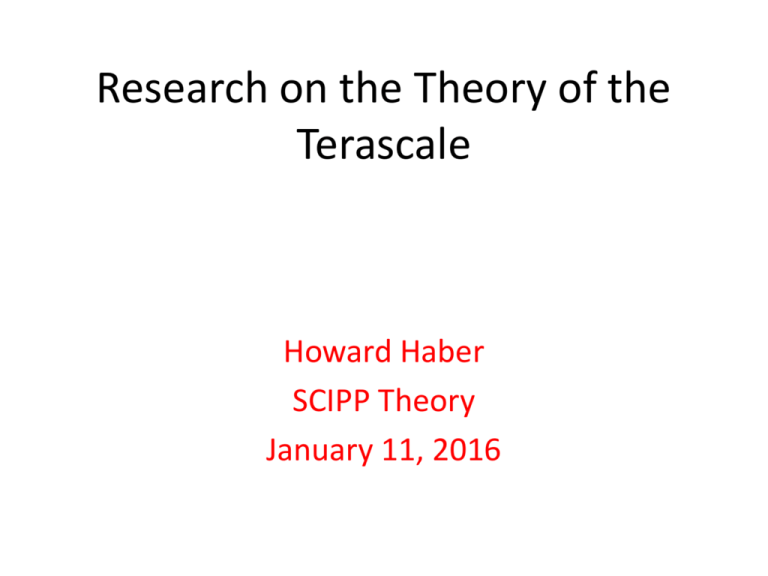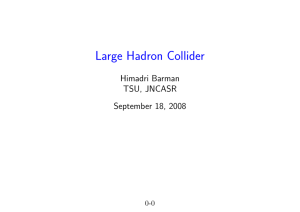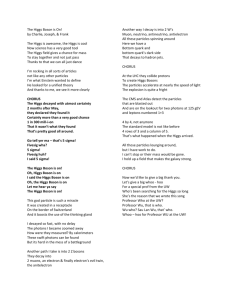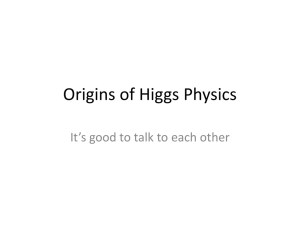Powerpoint
advertisement

Research on the Theory of the Terascale Howard Haber SCIPP Theory January 11, 2016 SCIPP Particle Theory Group • Michael Dine: supersymmetry, string theory, and the early universe • Howard Haber: Higgs bosons, collider physics, new physics beyond the Standard Model at the terascale (including supersymmetry) • Stefano Profumo: Theories of particle dark matter and their implications for astrophysics and collider phenomenology In addition, Anthony Aguirre and Joel Primack work on a variety of topics overlapping particle theory and astroparticle theory, including dark matter, early universe cosmology, inflation, … The Standard Model (SM) of Particle Physics The elementary particles consists of three generations of spin-1/2 quarks and leptons and the gauge bosons of SU(3)xSU(2)xU(1). Technically, massive neutrinos require an extension of the Standard Model, but most likely the relevant scale of the new physics lies way beyond the terascale. Origin of mass for elementary particles Naively, an SU(3)xSU(2)xU(1) gauge theory yields massless gauge bosons and massless quarks and leptons, in conflict with observation. The Standard Model employs the Higgs mechanism for mass generation. The SU(2)xU(1) electroweak gauge invariance is spontaneously broken down to U(1)EM, which yield the massive W and Z gauge bosons. In the simplest implementation, a spinless physical Higgs scalar is predicted. From Symmetry Magazine, volume 3, issue 6, August 2006 On July 4, 2012, the discovery of a new boson is announced which may be the long sought after Higgs boson. The discovery papers are published two months later In Physics Letters B. ATLAS Collaboration: Physics Letters B716 (2012) 1—29 CMS Collaboration: Physics Letters B716 (2012) 30—61 A boson is discovered at the LHC by the ATLAS Collaboration Invariant mass distribution of diphoton candidates for the combined 7 TeV and 8 TeV data samples. The result of a fit to the data of the sum of a signal component fixed to mH = 126.8 GeV and a background component described by a fourth-order Bernstein polynomial is superimposed. The bottom inset displays the residuals of the data with respect to the fitted background component. Taken from ATLAS-CONF-2013-012 (March, 2013). The distribution of the four-lepton invariant mass for the selected candidates, compared to the background expectation in the 80 to 170 GeV mass range, for the combination of the 7 TeV 8 TeV data. The signal expectation for a Higgs boson with mH=125 GeV is also shown. Taken from ATLAS-CONF-2013-013 (March, 2013). A boson is discovered at the LHC by the CMS Collaboration The diphoton invariant mass distribution with each event weighted by the S/(S+B) value of its category. The lines represent the fitted background and signal, and the colored bands represent the ±1 and ±2 standard deviation uncertainties in the background estimate. The inset shows the central part of the unweighted invariant mass distribution. Taken from Physics Letters B716 (2012) 30—61. Distribution of the four-lepton reconstructed mass in full mass range for the sum of the 4e, 4μ, and 2e2μ channels. Points represent the data, shaded histograms represent the background and unshaded histogram the signal expectations. The expected distributions are presented as stacked histograms. The measurements are presented for the sum of the data collected at √s = 7 TeV and √s = 8 TeV. [70-180] GeV range - 3 GeV bin width. Taken from CMS-PAS-HIG-13-002 (March, 2013). Winners of the 2013 Nobel Prize in Physics François Englert and Peter Higgs Probability of Higgs boson decay channels Question: why not search for Higgs bosons produced in gluon-gluon fusion that decay into a pair of b-quarks? Answer: The Standard Model background is overwhelming. There are more than 107 times as many b-quark pairs produced in proton-proton collisions as compared to b-quark pairs that arise from a decaying Higgs boson. Roughly 250,000 Higgs bosons per experiment were produced at the LHC from 2010—2013. Is the observed scalar at 125 GeV the SM Higgs boson? Best-fit results for the decay [left] and production [right] signal strengths (normalized to the SM predicted values) for the combination of ATLAS and CMS. The error bars indicate the 1σ (thick lines) and 2σ (thin lines) intervals. Reference: ATLAS-CONF-2015-044; CMS-PAS-HIG-15-002. Research program 1: theory and phenomenology of Higgs bosons Research program 2: theory and phenomenology of TeV-scale supersymmetry (SUSY) For a review, see H.E. Haber, Supersymmetry Theory, in K.A. Olive et al. [Particle Data Group Collaboration], Review of Particle Physics, Chin. Phys. C 38, 090001 (2014); and in the 2015 partial update for the 2016 edition, available on the web shortly. As a member of the Particle Data Group, I am the author of the biennial Supersymmetry Theory review Research program 3: explorations of the Terascale at present and future colliders (LHC and ILC) • Studies of the non-minimal Higgs sector • Precision measurements of new physics observables • Distinguishing among different theoretical interpretations of new physics signals • Employing the ILC as a precision Higgs factory • Terascale footprints of lepton-number-violating physics (e.g. R-parity-violation or the SUSY seesaw) • New sources for CP-violation (Higgs and/or SUSY mediated) 2015 Publications Scrutinizing the Alignment Limit in Two-Higgs-Doublet Models. Part 2: mH=125 GeV J. Bernon, J.F. Gunion, H.E. Haber, Y. Jiang and S. Kraml, arXiv:1511.03682 [hep-ph]. On the Alignment Limit of the NMSSM Higgs Sector M. Carena, H. E. Haber, I. Low, N.R. Shah and C.E.M. Wagner, arXiv:1510.09137 [hep-ph]. New LHC Benchmarks for the CP-conserving Two-Higgs-Doublet Model H.E. Haber and O. Stål, Eur. Phys. J. C 75, 491 (2015). Scrutinizing the Alignment Limit in Two-Higgs-Doublet Models. Part 1: mh = 125 GeV J. Bernon, J.F. Gunion, H.E. Haber, Y. Jiang and S. Kraml, Phys. Rev. D 92, 075004 (2015) . Preserving the validity of the Two-Higgs Doublet Model up to the Planck scale P. Ferreira, H.E. Haber and E. Santos, Phys. Rev. D 92, 033003 (2015). Complementarity Between Non-Standard Higgs Boson Searches and Precision Higgs Boson Measurements in the MSSM M. Carena, H.E. Haber, I. Low, N.R. Shah and C.E.M. Wagner, Phys. Rev. D 91, 035003 (2015). Search for deviations from SM-Higgs couplings 2D test statistics q(κV, κF) scan. Negative log-likelihood f f contours of κF versus κV for the combination of ATLAS and CMS and for the individual decay channels, as well as for their global combination (κF versus κV shown in black), without any assumptions on the sign of the coupling modifiers. Fit results for the two parameterizations allowing BSM loop couplings, with κV ≤ 1, where κV stands for κZ or κW, or without additional BSM contributions to the Higgs boson width, i.e. BRBSM=0. The measured results for the combination of ATLAS and CMS are reported together with their uncertainties. The error bars indicate the 1σ (thick lines) and 2σ (thin lines) intervals. Taken from ATLAS-CONF-2015-044; CMS-PAS-HIG-15-002 (September, 2015) Implicat ions of a SM -like Higgs boson Typically, none of the scalar states of an extended Higgs sector will resemble a SM-Higgs boson. However, a SM-like Higgs boson ( h SM ) can arise in two dif ferent ways: • T he decoupling limit (Haber and Nir 1990, Gunion and Haber 2003) All but one of the scalar states ( h ) are very heavy (with masses of order M ≫ m h ). Integrating out the heavy states below the mass scale M yields an effective one-Higgs-doublet theory—i.e. the Standard Model, and h ≃ h SM . • T he alignment limit wit hout decoupling (Craig, Galloway, Thomas 2013, Haber 2013) Electroweak symmetry breaking occurs when the vacuum value of a scalar field with electroweak quantum numbers is nonzero. In theories with multiple scalars, the scalar field vacuum expectation value points in some direction in the field space. If this direction is exactly aligned with one of the scalar mass-eigenstates h , then this scalar field will correspond to a state whose characteristics are precisely those of the SM Higgs boson. This alignment is automatically achieved in the decoupling limit. However, in special cases, the alignment limit can be attained even if all Higgs scalar masses are of the same order of magnitude. In the alignment limit, significant deviations from SM behavior can be seen in the triple Higgs coupling in certain regions of the two Higgs doublet model parameter space. Taken from J. Bernon et al., Phys. Rev. D 92, 075004 (2015) . Allowed region of MSSM Higgs parameter space in the mhalt scenario where 2HDM alignment without decoupling is achieved for tan𝛽~10 due to one-loop radiative corrections. A 7 parameter pMSSM scan to generalize the constraints on the mhalt scenario. Red points are with 1σ of the best fit point and yellow points are within 2σ of the best fit point. [T. Stefaniak and collaborators, after revisiting the results obtained by M. Carena et al.] My recent Ph.D. students and their thesis projects John Mason (2008): Hard Supersymmetry-Breaking “Wrong-Higgs” Couplings of the MSSM Deva O’Neil (2009): Phenomenology of the Basis-Independent CP-Violating Two-Higgs Doublet Model Laura Fava (2015): Precision Measurement of UED Coupling Constants Using Like-Sign Leptons at the LHC Edward Santos (2015): Renormalization Group Constraints on the Two-Higgs Doublet Model Where are they now? J. Mason – following a three-year post doctoral research associate in particle theory at Harvard University, John accepted a position as an assistant professor of physics at Western State College of Colorado D. O’Neil – assistant professor of physics at Bridgewater College (in Virginia) L. Fava and E. Santos – participated in the Insight Data Science Fellows Program; found employment in Silicon Valley. Current Ph.D. students Laurel Stephenson Haskins: Puzzle in the relation between the quark anomalous dimension and the mass anomalous dimension in supersymmetric non-abelian gauge theory. This project led to a more careful study of infrared divergences and gauge invariance in Supersymmetric QED (in collaboration with Michael Dine and Patrick Draper). Ongoing and Future Activities Partially Natural 2HDM (with P. Draper and J. Ruderman) • Implementing the second fine tuning of the 2HDM with a symmetry. Implications of 2HDM flavor alignment at a very high energies (with S. Gori and E. Santos) • Generating manageable flavor violation at the electroweak scale via renormalization group running. LHC Benchmarks for more general 2HDMs (with T. Stefaniak) • Putting in CP violation and Z2 symmetry breaking effects in the 2HDM in the HiggsSignals program. Higgs alignment in the radiatively corrected 2HDM revisited (with T. Stefaniak) • A more comprehensive scan of the pMSSM parameter space. Implications of evidence for new physics in Run II of the LHC • Co-convening the Higgs sessions of the KITP Workshop, Experimental Challenges for the LHC Run II (March 28—June 3)





